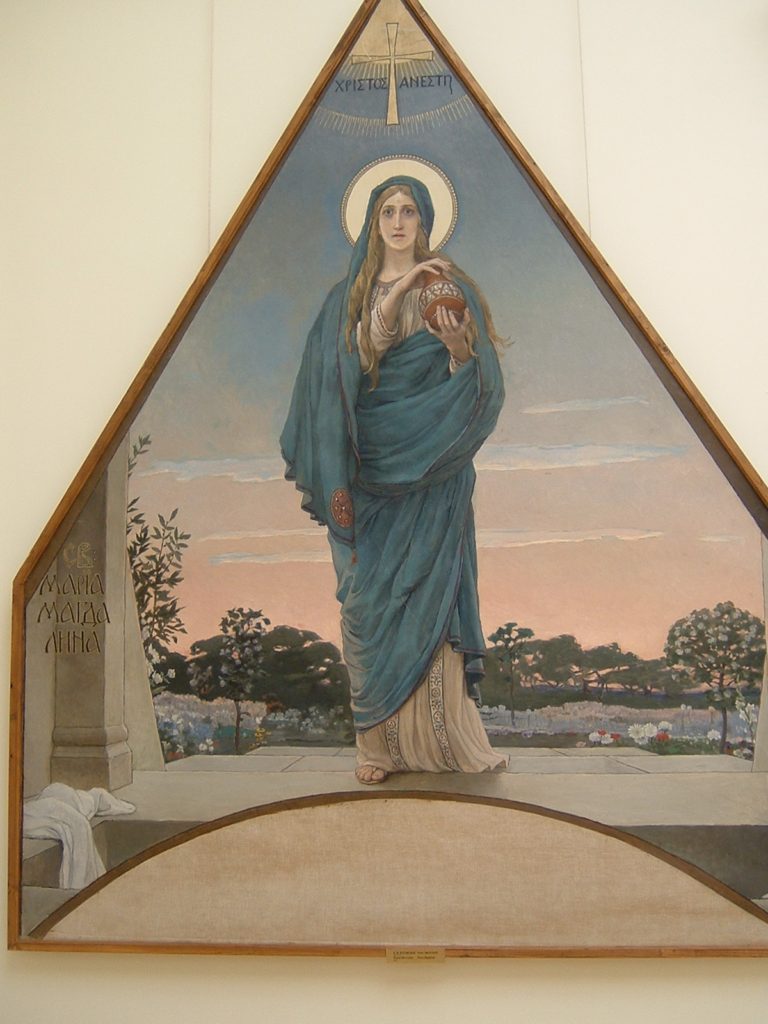by Ani Williams
(Original article written in 2003, with an updated intro with new information in June 2019)
“And all shall be well and
All manner of thing shall be well
When the tongues of flame are in-folded
Into the crowned knot of fire
And the fire and the rose are one.”
— From ‘The Little Gidding’, the last of T S. Eliot’s Four Quartets.
The Fire and the Rose are One
I discovered this extraordinary quote carved in a window at Salisbury Cathedral, where the great poet T.S. Eliot is buried. It was 1987 when I first visited that cathedral, and began exploring Britain’s magical landscape and sites of the Magdalene. I often carried a copy of Eliot’s collected poems as a traveling companion–to be read next to a warm, crackling fire on cold nights in Scotland or with a good cup of English tea in Devon or Somerset in the gentle rolling green hills of southwest England. Eliot’s poems well captured the depth and multi-dimensional qualities of my experiences in those early visits to Scotland, Wales and England.
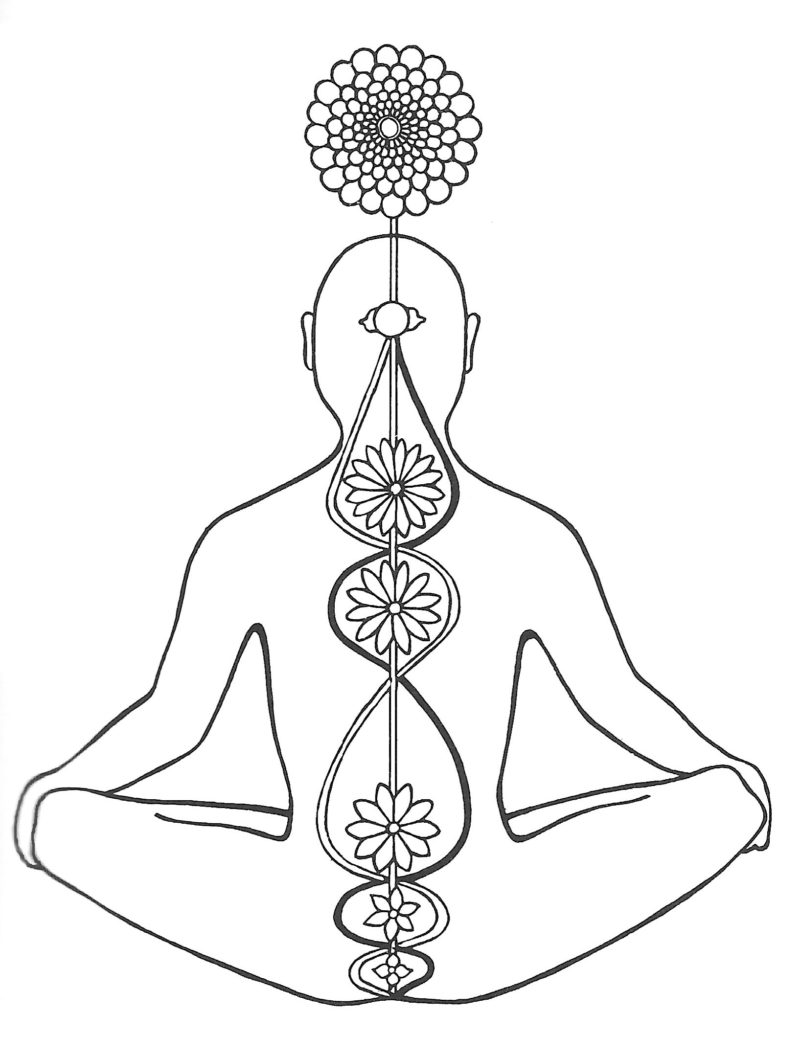 What I did not realize at the time, was that this particular quote describing the crowned knot of fire, describes ancient Tantric practices. The visual that comes to mind is the journey of Kundalini through the lotus portals, as the fire of Shakti rises through the central channel of the spinal column, ultimately reaching the ‘knot of Brahma’–Brahma-granthi, at the crown, the ‘crowned knot of fire.’
What I did not realize at the time, was that this particular quote describing the crowned knot of fire, describes ancient Tantric practices. The visual that comes to mind is the journey of Kundalini through the lotus portals, as the fire of Shakti rises through the central channel of the spinal column, ultimately reaching the ‘knot of Brahma’–Brahma-granthi, at the crown, the ‘crowned knot of fire.’
In Tantric practice, sound mantras and breath or prana, activate one’s inner fire. The circulating and rising energies ideally unite at the crown chakra, and Shakti becomes one with Shiva. The release of the nectar of alchemical union within immerses the practitioner in ineffable bliss…as in the practice of Heiros Gamos (Greek Χειρός γάμος), or sacred union.
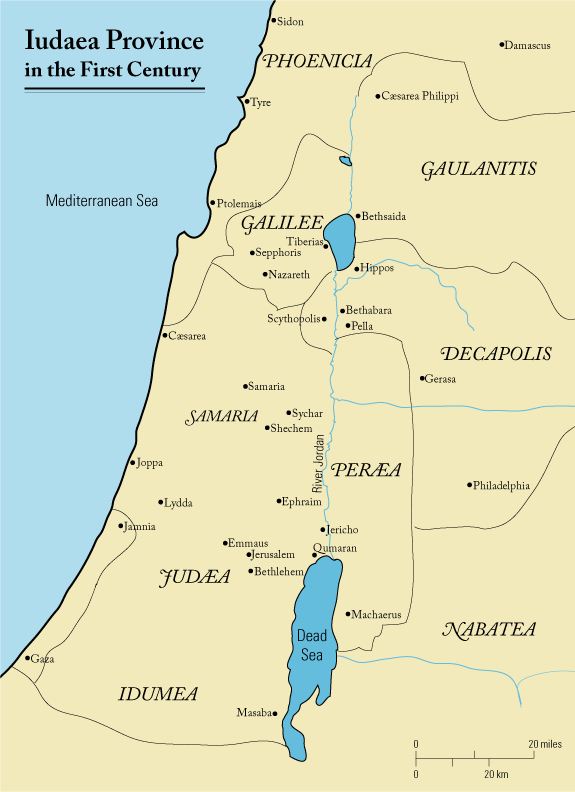 “…When the tongues of flame are in-folded into the crowned knot of fire
“…When the tongues of flame are in-folded into the crowned knot of fire
And the fire and the rose are one.” T.S. Eliot was a brilliant man, but did he truly realize the deeper meaning of his chosen words? I have no idea, however, it spoke volumes to me, and still does after all these decades. I believe that Jesus would have learned these ancient Vedic tantric traditions on his journeys to India. And certainly, if many accounts are true, Mary Magdalene would have studied tantric  alchemy during her years of training as a priestess in the temples of Artemis, and Isis. The canonical gospels speak about Jesus and the inner circle of disciples traveling across the Jordan River from Jerusalem and Bethany to Perea, where one the largest temples to Artemis existed during that time. Also we have accounts of Jesus’ mother Mary living in Ephesus, the site of another well-known temple of Artemis. The Holy Family was well familiar with these temples and traditions honoring the Great Mother.
alchemy during her years of training as a priestess in the temples of Artemis, and Isis. The canonical gospels speak about Jesus and the inner circle of disciples traveling across the Jordan River from Jerusalem and Bethany to Perea, where one the largest temples to Artemis existed during that time. Also we have accounts of Jesus’ mother Mary living in Ephesus, the site of another well-known temple of Artemis. The Holy Family was well familiar with these temples and traditions honoring the Great Mother.
“Magdalena, an apostle of the new and greatest hope.”
–Pope Francis, Vatican City 2017
It took two thousand years for Maria Magdalena to be fully recognized by the Roman Catholic Church. On May 17, 2017 Pope Francis declared the following to a full assembly of official leaders in the Vatican:
“By calling Mary Magdalene by name after his resurrection.…Mary becomes an apostle of hope for the world, announcing the Lord’s rising.
“Mary: the revolution of her life, the revolution destined to transform the existence of every man and woman, begins with a name that echoes in the garden of the empty tomb. So that woman, who is the first to encounter Jesus…now has become an apostle of the new and greatest hope.” –Pope Francis, Vatican City 2017
The Thunder Perfect Mind is one of the texts discovered at Nag Hammadhi, Egypt in 1945, an extraordinary collection of scrolls that were not included in the bible. It perfectly describes the great polarizing of the feminine archetype, the so-called sacred and profane. In embracing and integrating these qualities within ourselves, and in our understanding of the Magdalene, there is great healing possible:
“I am the first and the last–I am the honored one and the scorned one…I am the wife and the virgin.”
From my perceptions and visions of Magdalene over many decades, I believe that Magdalene as the sacred Bride, would have practiced a very conscious and pure level of union with Yeshua (Jesus’ name in Aramaic). During an extraordinary vision that occurred on Winter Solstice in 2002, I witnessed their sacred union, symbolized as the Lady and the Unicorn, similar to the Unicorn and Our Lady tapestries in the Cluny Museum, Paris. Their Heiros Gammos created unlimited light, and this energy manifested as electro-magnetic particles spreading throughout the cosmos…Shiva and Shakti impregnating the realms with life energy.
As I sat to begin writing this article in 2003, I pondered the great variety of terms used to describe Maria Magdalena…from beloved bride, companion of Jesus and Apostle to the Apostles, to sinner and prostitute. Her power, her gifts and her pre-eminent position among the Apostles would have made a woman of her time a very inconvenient and a threatening personality for religious leaders. A few of the terms often used to describe our Maria Magdalena are:
Scarlet Woman, penitent sinner, Sister-Bride, whore, Black Madonna, high Priestess of Isis, Mistress of the  Elements, Beloved wife of Jesus, favored disciple, Mary of Bethany, Miriam of Magdala, Magdal-eder, the tower-stronghold, Daughter of Sion, Maria-Sophia, the Woman who saw all, are just some of the titles and attributes accorded to her. She has been described as ‘beauty consuming itself like incense, far from the eyes of men’; troubadours have sung of the fruit of her womb, the Sangraal, the living Grail mysteries and the Sang Raal, the bloodline of Jesus. Yet do they have any idea of the endless years of her focused spiritual training and her years of dedicated ministry in the Church of Love? She is calling now, for the authentic voice of wisdom and power to come forth in all women… for beauty and truth shall save the world.
Elements, Beloved wife of Jesus, favored disciple, Mary of Bethany, Miriam of Magdala, Magdal-eder, the tower-stronghold, Daughter of Sion, Maria-Sophia, the Woman who saw all, are just some of the titles and attributes accorded to her. She has been described as ‘beauty consuming itself like incense, far from the eyes of men’; troubadours have sung of the fruit of her womb, the Sangraal, the living Grail mysteries and the Sang Raal, the bloodline of Jesus. Yet do they have any idea of the endless years of her focused spiritual training and her years of dedicated ministry in the Church of Love? She is calling now, for the authentic voice of wisdom and power to come forth in all women… for beauty and truth shall save the world.
We begin our journey following Magdalene’s trail of legends and shrines throughout France and Britain, as mysterious threads of a tapestry — a story whose time has finally come. Her presence is suddenly re-emerging in books, new translations of Gnostic gospels, television specials and film, making her way into our psyches and preparing new ground for healing at least 4000 years of separation of spirit and sensuality. When the primary aspects of one’s true essential nature (Tibetans would term this Ground Luminosity) are fragmented, outside forces (such as relationships, family, church or government) can easily dominate and manipulate one’s life. Magdalene’s legacy calls us to retrieve the fragments of our sensual, passionate natures, and when impregnated with divine love and a spiritual fire, the alchemy of sacred union transforms us. She represents a profound knowledge of the mysteries of the sacred marriage, earthly and heavenly union, embodied spiritual passion and a necessary lost chord in the remnants of the song of the sacred feminine.
“The people shall rejoice and dance within, and all the kingdoms shall rise together as if from the mist of the dreams of humanity, and forge a union with the divine… and man shall join woman in the final dance of alchemy.” ‘I Remember Union —The Story of Maria Magdalena’ by Flo Aeveia Magdalena.
Signs of the Grail in Avalon
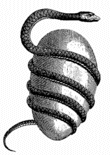
When I made my first journey to the sacred sites of Great Britain in 1987, I had no idea how deeply I would be impacted by the rich layers of Mary’s story that are still palpable and readily accessible to modern pilgrims. In Glastonbury, England, the site of ancient Avalon, I was struck with the ‘presence’ of both Mary’s—Mary Mother of Jesus and Mary Magdalene, in the shrines, cathedral ruins, springs, and even her presence in the land itself. The St. Michael and St. Mary ley lines (dowsed lines of energy) weave back and forth over each other across England, intersecting at the major archeological sites and early Christian cathedrals. Mary’s dragon line moves in a serpentine flow, crossing the straight Michael line in a repeating geomantic hieros-gamos or signs of sacred union in the land. (See The Sun and The Serpent by Hamish Miller and Paul Broadhurst).
deeply I would be impacted by the rich layers of Mary’s story that are still palpable and readily accessible to modern pilgrims. In Glastonbury, England, the site of ancient Avalon, I was struck with the ‘presence’ of both Mary’s—Mary Mother of Jesus and Mary Magdalene, in the shrines, cathedral ruins, springs, and even her presence in the land itself. The St. Michael and St. Mary ley lines (dowsed lines of energy) weave back and forth over each other across England, intersecting at the major archeological sites and early Christian cathedrals. Mary’s dragon line moves in a serpentine flow, crossing the straight Michael line in a repeating geomantic hieros-gamos or signs of sacred union in the land. (See The Sun and The Serpent by Hamish Miller and Paul Broadhurst).
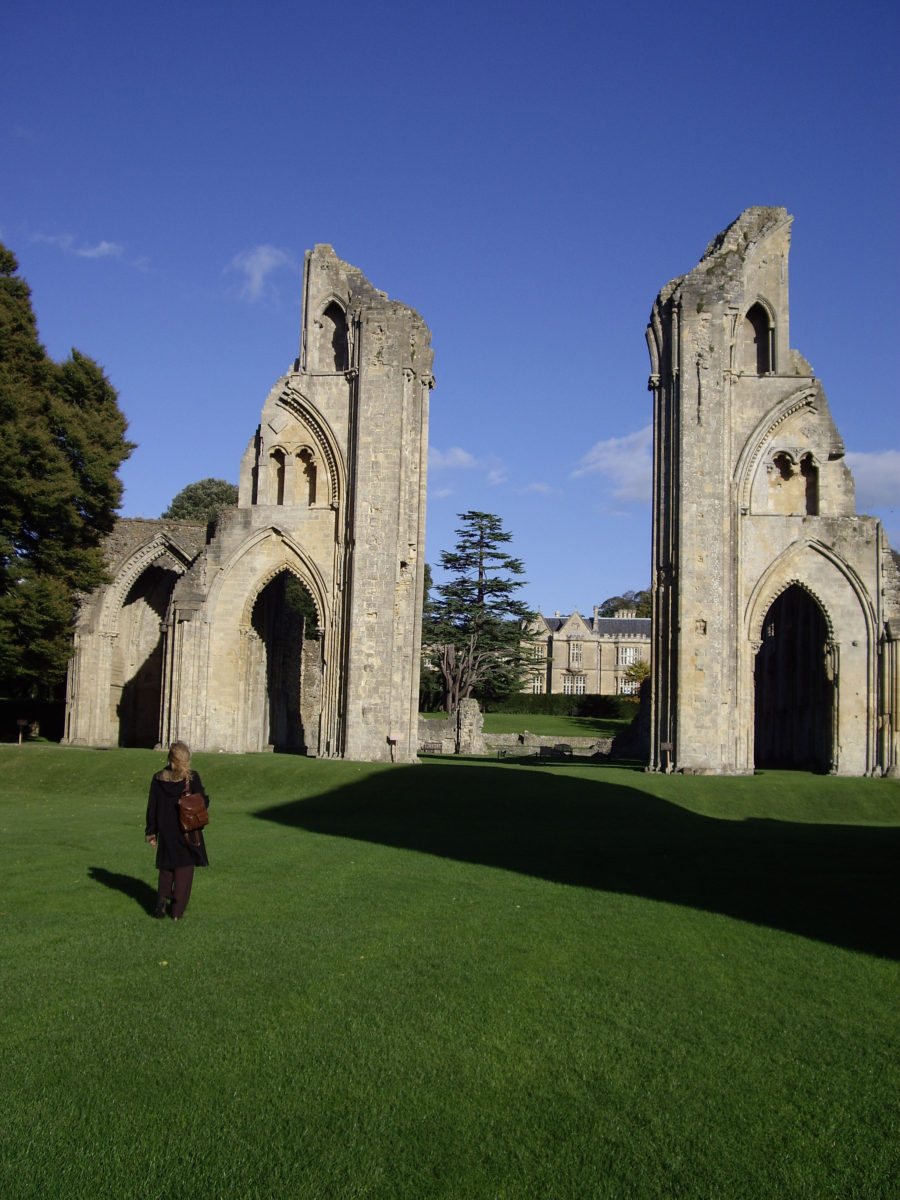 The famous Glastonbury Abbey with it’s Mary Chapel was founded in its original humble form of mud and thatch sometime between 41- 63 A.D. by Joseph of Arimathea. In fact, it was the world’s first Christian church above ground. (The earliest Christians were forced to meet underground in both Jerusalem and Rome, to avoid persecution). According to the 1922 publication ‘St. Joseph of Arimathea at Glastonbury’ by Lionel S. Lewis, Joseph came to the Isle of Glas, an older name for Glastonbury, in about 31 A.D. with ten companions to spread Christ’s message. It is said that they were told in a vision by the Archangel Gabriel to build a church in honor of Mary. One legend states that after Mary died, Joseph brought her body to Glastonbury, to be buried in a crypt at the present Mary Chapel of the Abbey. This Mary is normally presumed to be Mary, the ‘Virgin’ Mother, but could it be the other Mary, The Magdalene? (There are other legends that say she is buried in France).
The famous Glastonbury Abbey with it’s Mary Chapel was founded in its original humble form of mud and thatch sometime between 41- 63 A.D. by Joseph of Arimathea. In fact, it was the world’s first Christian church above ground. (The earliest Christians were forced to meet underground in both Jerusalem and Rome, to avoid persecution). According to the 1922 publication ‘St. Joseph of Arimathea at Glastonbury’ by Lionel S. Lewis, Joseph came to the Isle of Glas, an older name for Glastonbury, in about 31 A.D. with ten companions to spread Christ’s message. It is said that they were told in a vision by the Archangel Gabriel to build a church in honor of Mary. One legend states that after Mary died, Joseph brought her body to Glastonbury, to be buried in a crypt at the present Mary Chapel of the Abbey. This Mary is normally presumed to be Mary, the ‘Virgin’ Mother, but could it be the other Mary, The Magdalene? (There are other legends that say she is buried in France).
Margaret Starbird, in her book ‘The Woman with the Alabaster Jar’, states, “Some of the later European legends say that Joseph of Arimathea caught the blood of the dying Jesus in a chalice and brought it to Western Europe by boat during the early persecution of the followers of Jesus in Jerusalem (A.D. 42). One chronicler preserves the story that Joseph of Arimathea brought two cruets containing the blood and sweat of Jesus to Glastonbury England, and a staff of hawthorn that sprouted and bloomed when it was planted.”
(Several offspring of that original hawthorn, a species that is only found here and in the Middle-East, are still growing in Glastonbury… within the Abbey grounds, on Wearyall Hill and at Chalice Well Gardens. It blooms during the Christian holy weeks at Easter, and Christmas, or Winter Solstice, and is a powerful symbol of death and birth, as its red fruit and white flowers happen at the same moment.)

Numerous legends tell of Joseph of Arimathea traveling with a young Jesus to Britain. It was known that Joseph was involved in tin trade between Cornwall and the Mediterranean. This trade route for metals was well known to Phoenicians and Greeks since at least 900 BC. When I first visited Cornwall in 1987, I stood in the ruined castle of Tintagel, gazing out to the Atlantic expanse and had a powerful vision. I saw a large ship coming into the harbor with a boy Jesus at the prow. This vision occurred before I had heard the stories of Jesus coming to Britain with Joseph of Arimathea.
Following the crucifixion, Mary Magdalene and several members of the Holy Family fled to Egypt, later landing on the southern coast of France, at a town now known as Les Saints-Marie-de-la -Mer. It is not known whether or not Magdalene later accompanied Joseph of Arimathea further north into Britain, but at Bride’s Mound, on the western edge of Glastonbury, there are a few scattered remains of a stone wall from an old Magdalene Chapel.
It is also near Bride’s Mound that the ancient Blue Bowl was uncovered in the early 1900’s and many British mystics claimed it was a Grail bowl (some experts date it between the 1st century to about 700 A.D). It has since been removed, but at the time of first writing this article, the Blue Bowl was being kept at Chalice Well. On our annual Magdalene pilgrimages to Britain, our groups have had the opportunity to use the bowl in meditations. Many of us received messages from Jesus and Magdalene regarding their union during these sessions.

Just a few hundred yards from Chalice Well and in the center of the village is the Mary Chapel of the famous Glastonbury Abbey. In one corner of the chapel, a beautiful little well dedicated to St. Joseph still runs with clear Avalon white spring water. And on the southern outside wall there is a most intriguing inscribed stone, perhaps alluding to the sacred marriage of Jesus and Magdalene, Jesus Maria. These are the very same words on a banner carried by Joan of Arc during the crusades, relating to the wedding at Cana and the bloodline of the Holy Grail. Just outside the Mary Chapel, lay the purported graves of King Arthur and Guinevere, continuing this theme of the sacred marriage!
In tracking the names and remnants of the Grail Mystery, The healing waters of the red and white springs of Avalon give another clue to the alchemy of union, of earth and spirit, female and male. The white (chalk) spring pours liberally from the base of the Tor, the ‘yang’ central high point in the landscape, and the red spring emerges within the ‘yin’ nurturing Chalice Well Gardens just a few feet away… it is also called the blood spring, as it is full of natural iron, causing the well stones’ strong red color. Two very old “bleeding” yew trees stand as a gateway to the lower end of the garden, where the red spring flows into two interlocking pools, a shape well-known in sacred geometry called the Vesica Pisces. This shape is constructed by drawing two equal circles so that the center of each lies on the circumference of the other. This symbol of sacred union is an important symbol in Christian mysticism (sign of the fish, or Pisces) and the geometry of ancient temple design, including the Mary Chapel.

“The Vesica Pisces is a powerful symbol of the creation and regeneration of forms in the natural world, and given the long and successive use of the site of the two springs as a place of death and rebirth, it is not surprising that this generative symbol should appear.” — From ‘The Red and White Springs’ by Nicholas Mann.
Signs and remnants of both Mary Magdalene and Mother Mary abound in Britain, as well as the Grail Mysteries and symbols of sacred union, the path of the Beloved.
This theme of the two Mary’s began gestating within me nearly twenty years ago, and continues to unfold my own developing understanding of the sacred feminine. This process is an inner integration of the mythos of both Mother Mary and Mary Magdalene, the embracing of a powerful earthy sensual aliveness of the Magdalene, the path of The Beloved, and the heavenly and transcendent love of the Mother. Even though these two Mary’s have become widely separated in the human psyche, I believe it is time we reconcile these polarities as necessary step of healing our world.
Magog, the grandmother oak speaks:
On my annual pilgrimage to Avalon this last May, I allowed an extra week of personal retreat time at Chalice Well Gardens to contemplate more deeply the Magdalene. My intention was to delve into her mysteries, and perceive how she might be an essential metaphor for our world out of balance. I had a hunch that the wisdom of old Magog, the grandmother oak tree might shed some light. (Magog and Gog are the only two survivors of an ancient ceremonial avenue of oaks leading up to the Tor).
As I sat at the foot of this matriarch, I ‘heard’ the following message:
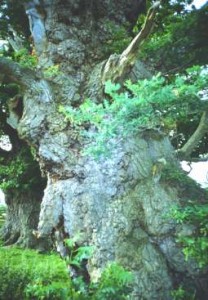 “I am the alchemy of the interaction of elements—drawing my blood, sap, resins from the deep earth, mixing with sunlight, air, water, giving new life. Knowledge and deep memory is held in my sap-blood—the same as your blood. Magdalene impregnated the earth here in this land (Avalon) with her essence, embedding her lineage, knowledge, her experience and mastery of light in the land, in the soil, to be contacted by all who touch this land—a transmission through holy blood. The trees continue this alchemy, from earth and sky mixing, recreating, renewing through the elements, the ancient roots, and the ancient feminine bloodline are alive in us. The story always recreates itself in new life, acorns will sprout new oaks and our mystery continues on and on.” — Magog the Grandmother Oak
“I am the alchemy of the interaction of elements—drawing my blood, sap, resins from the deep earth, mixing with sunlight, air, water, giving new life. Knowledge and deep memory is held in my sap-blood—the same as your blood. Magdalene impregnated the earth here in this land (Avalon) with her essence, embedding her lineage, knowledge, her experience and mastery of light in the land, in the soil, to be contacted by all who touch this land—a transmission through holy blood. The trees continue this alchemy, from earth and sky mixing, recreating, renewing through the elements, the ancient roots, and the ancient feminine bloodline are alive in us. The story always recreates itself in new life, acorns will sprout new oaks and our mystery continues on and on.” — Magog the Grandmother Oak
During the days following, I continued to sense the magic of this cleansing property of the elements, the fierce wind and rain sweeping across the moors, the sudden warm sun breaking through, lighting the raw power and presence of the stones, working alchemically to cleanse and renew, not only the land, but also myself.
“From prehistoric times, the Universal Goddess had appeared in many guises and had been known by many names; however personified, she was always identified with Isis the Universal Mother, Mistress of all the Elements…” ‘Bloodline of the Holy Grail’ by Lawrence Gardner. (Isis is the Beloved of Osiris, both masters of the alchemy of transmutation through the elements)
I was reminded of two visions my friend Stanley Messenger had many years ago of Mary Magdalene. Stanley is living in Glastonbury, a well-respected mystic and teacher, and even at nearly ninety years old, still actively sharing his wisdom with many. The first vision he shared with me was that of seeing Magdalene in the Glastonbury Abbey, where she was waist deep in the earth with her breasts resting on the ground. Her hands were turning, working the soil, as if mixing her awareness with the earth, an alchemical blending. When Stanley realized what she was doing, she turned and winked at him.
“And you, O Magdal-eder,
Tower-Stronghold of daughter Sion,
Through you shall it come.
The former dominion shall be restored…
But for now you shall dwell in the fields…
And from there you shall be rescued.” (Mic.4:8-10)
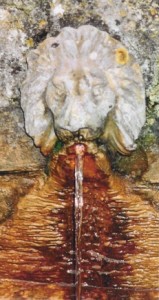
On another occasion in La Val Dieu (Valley of God), France, near Rennes le Chateau, where she is said to have lived following the crucifixion, Stanley and a friend both saw a woman they felt to be Magdalene bending down in a field, turning the soil and the ground was bleeding. The vision faded, but they had both seen the same image. Once again, she is seen working her magic in the earth, lady of the elements, transforming matter, revealing and maintaining the truth of the Blood Mysteries.
Sue Palmer, a colleague of Stanley’s, is known for her dramatic one-woman show ‘The Magdalene’. As I spoke to her in Glastonbury last May, she said, “Britain is the path of love, the path of the sacred rites of Mary’s knowledge and bloodline, but always the path of love. She has a greater capacity for love—there is the story of her journey into the deep cave systems in France, where she is said to have journeyed for two thousand years. On emerging out of the caverns, light poured from her eyes like liquid pearls.”
“I am the single radiance by which all is aroused, and within which it is vibrant…
For the man who has found me, the door to all things stands open…
I am the magnetic force of the universal presence and the ceaseless ripple of its smile.”
(Excerpts from Hymn To the Eternal Feminine by Teilhard de Chardin)

What history tells us about Magdalene
Few biographical details about the life of MM can be found in the Biblical and Gnostic texts. However, one of the main sources is found in the writings of Blessed James of Voragine (c.1230-1298), author of ‘The Golden Legend’. According to Voragine, Mary was of royal blood, the daughter of Syrus (Syrian) and Eucharia (from eucharis, gracious, a term applied to Aphrodite). She, her brother, Lazarus and her sister Martha owned seven castles, in addition to the village of Bethany and much of Jerusalem.
Gnostic references refer to her as the favored disciple in the inner circle traveling with Jesus. The following quote spoken by Jesus to Magdalene illustrates her exalted role as a woman among the other disciples:
“Mariham, Mariham, the happy, this whom I shall complete in all the mysteries of the things of the Height. Speak in boldness, because thou art she whose heart straineth toward the Kingdom of the heavens more than all thy brothers… you who will give light upon everything in accuracy and in exactness.” From Pistis Sophia (Askew Codex), quoted in the book ‘Mary Magdalen’ by Susan Haskins.
The Gnostic Gospel of Philip describes Magdalene as “… the companion of the Saviour. But Christ loved her more than all the disciples and used to kiss her often on the mouth. The rest of the disciples were offended by it and expressed disapproval. They asked, ‘why do you love her more than all of us?’ The Saviour answered and said to them, ‘Why do I not love you like her: When a blind man and one who sees are both together in darkness, they are no different from one another. When the light comes then he who sees will see the light, and he who is blind will remain in darkness…”
 She anointed Jesus twice with her alabaster jar of Nard, once upon his head, and another time at his feet, wiping them afterwards with her long hair. This fragrant, sweet-smelling ointment is known as Spikenard, which in those days grew high in the Himalayan Mountains. This would have been part of the sacred marriage ritual known to the high priestesses of that time. However, for two millennia, Magdalene has been portrayed by the church as a sinner and prostitute, not as Bride. Yet, in the Old Testament’s Song of Solomon, a series of beautiful love canticles between a bridegroom and his bride, this act of anointing is identified as symbolic of espousal.
She anointed Jesus twice with her alabaster jar of Nard, once upon his head, and another time at his feet, wiping them afterwards with her long hair. This fragrant, sweet-smelling ointment is known as Spikenard, which in those days grew high in the Himalayan Mountains. This would have been part of the sacred marriage ritual known to the high priestesses of that time. However, for two millennia, Magdalene has been portrayed by the church as a sinner and prostitute, not as Bride. Yet, in the Old Testament’s Song of Solomon, a series of beautiful love canticles between a bridegroom and his bride, this act of anointing is identified as symbolic of espousal.
“You spread a banquet before me, you anoint my head with oil”.
In ancient Hebrew, Sumerian and Egyptian times, priestesses were trained in music, healing arts, and high magic, using chant, sacred dance and herbal unguents as medicine. During the third and fourth centuries A.D., Emperor Constantine and the council at Nicea decreed that women were forbidden to speak or sing in church and the healing traditions of women across the Mediterranean and Europe were suppressed.
The following quote from ‘The Gospel of Mary Magdalene’, a translation from the Coptic text with commentary by Lean-Yves Leloup, reveals more:
“Mary’s identity as a prostitute stems from Homily 33 of Pope Gregory I, delivered in the year 591… Only in 1969 did the Catholic Church officially repeal Gregory’s labeling of Mary Magdalene as a whore, thereby admitting their error—though the image of Magdalene as the penitent whore has remained in the public teachings of all Christian denominations. Like a small erratum buried in the back pages of a newspaper, the Church’s correction goes unnoticed, while the initial and incorrect article continues to influence readers.”
In his book ‘Genesis of the Grail Kings’, Lawrence Gardner follows the influence of Lilith, a Goddess of extreme light and dark, ‘black but beautiful’, an unusually free spirit, and the original femme fatal. “It was in its dealings with the heritage of Lilith that the Jewish Church of the Middle-Ages came to shadow the Christian Church’s denigration of Mary Magdalene—and it was for the very same reason that she was proclaimed a wicked harlot and a sorceress. Whereas Mary Magdalene was the wife of Jesus and the mother of the sacred Bloodline (the Sangreal) from the 1st century, it was with Lilith that it al began, about 4000 years before.”
Mary Magdalene was one of the women, along with Jesus’ mother Mary, at the foot of the crucifixion cross, and according to the Gospel of John, the first woman to arrive at the garden and see the Risen Christ. Her presence with Jesus in the garden not only reveals her key position with Him, but places Magdalene at the center of the Resurrection Mysteries.
The Pentagram and Venus in Magdalene’s Land
Legends abound regarding Magdalene’s tenure in southern France, arriving with her small entourage under the protective guidance of Joseph of Arimathea in about 42 A.D. (following the crucifixion). And now, every year on the twenty-fifth of May, throngs crowd into the seaport village of Saints-Marie-de-la-Mer to carry her effigy through the streets, with the music of the many gypsies and their horse-drawn carts, who have gathered from all over Europe to celebrate Magdalene’s arrival.
In about 1971, a British writer and scholar named Henry Lincoln arrived in nearby Rennes-le-Château (Queen of the House) to research his theories on the royal bloodline of the House of David, the lineage of Magdalene and Jesus. (He is known for his book Holy Blood, Holy Grail, co-authored with Michael Baigent and Richard Leigh). Rennes is perched on a steep mountaintop, about twenty-five miles from Carcassonne, an impressive medieval walled city. For centuries, it has been on the ancient Christian pilgrimage route, which stretched from northern Europe to Santiago de Compostela, Spain (translating as land of stars). Paulo Coelho (Diary of a Magus) and Shirley MacLaine (The Camino) have both written of the mystery and magic of their own long walks along this sacred path.

A: Bezu summit, (maps name the spot as Chateau Templier Ruines).
B: High mountain point aligned with two Templar churches, Antugnac and Granes.
C: Tour Magdala at Rennes
D: Blanchefort, ruin of an ancient watch tower.
E: La Soulane Mountain, visible local high point
Henry Lincoln has dedicated three decades to decoding Mary’s mysteries in the land surrounding Rennes, and his findings are documented in his book ‘Key To The Sacred Pattern’. Lincoln also produced a series of BBC documentaries covering the Rennes mysteries, one of which was ‘Shadow of the Templars’, showing his discoveries of a five-pointed star in the relationship of the mountains and key Templar shrines around Rennes, and the star’s hidden image in the old parchments of the Priory of Sion.

Rennes-le-Château’s village church was consecrated to the Magdalene in 1059 and in 1891, the parish priest, Berenger Sauniere began church restorations, adding new altars honoring the Magdalene. In this process, he discovered old parchments, one dating from 1244, another from 1644, said to contain genealogies of the royal bloodline.
The Priory of Sion was tied with the Knights Templar and claims of the Merovingian kings to be descendents of the Davidic bloodline through the lineage of Mary Magdalene and Jesus. Many of the Parisian elite belonged to this secret society, including the French music composer Claude Debussy, listed as Grand Master of the Priory of Sion.
Because of Magdalene’s role in the Crucifixion and Resurrection of Jesus, she was seen by the Gnostics and mystics of the Middle-ages to be ‘The Medium of Secret Revelation.’ These same Gnostics also associated her with the planet Venus. In the cultures of Egypt, China, Babylon, Druids, Mayans and many more, the movements of the stars and planets determined ceremonial cycles and the building patterns of megalithic sites and temples. Lincoln states:
“As they turn, the planets are showing us the mysterious workings of God’s hand, expressed in the harmonious movements of the spheres… each planet, as it revolves in its orbit, reaches positions where Earth, Sun and Planet form distinct alignment patterns… only one planet shows us a perfect geometrical form. This form is pentagonal and the planet is Venus. Creating five equally-spaced alignments over a period of eight years, she draws the perfect, hidden and secret symbol of the five-pointed star in the heavens… as above, so below. The very landscape bears the sign of her secret revelation.”
Sedona’s Pentagram and Madonna Rock
In esoteric mystery schools, the pentagram represents creative power and the potential realized human. The ideal physical proportions are seen by overlaying the human form upon the pentagram, with the reproductive organs at the center. The five-pointed stars appear repeatedly on the Egyptian temple walls, symbolizing Eternity, and in another Egyptian reference, when one both perceives and expresses beauty through all five senses, the possible ‘star’ human is born. To the Pythagoreans, it is the number love because it represents three, the first male number, and two, the first female number. Again, we find references to the sacred marriage and the alchemy of Magdalene’s love and reflections of that sacred harmonic perfection. According to John Anthony West, in ‘Serpent in the Sky’, “Five may also be called the universal number, as from the roots of two, three and five, all harmonic proportions and relationships can be derived. The interplay of these proportions and relations commands the forms of all matter… Five is the key to the vitality of the universe, its creative nature.” And in the alchemy of the elements of creation, the fire, earth, air, water and ether (spirit) work their magic to cleanse, renew and transform all forms of life
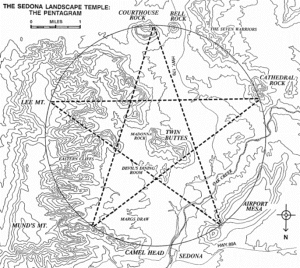
In Sedona’s landscape temple, we find the Madonna impressing her healing image, reminding us again of her message of eternal life and love. In Nicholas Mann’s book ‘Sedona Sacred Earth’, he presents his discovery of a natural five-pointed star pattern in the red rocks, with the dominant high points of the landscape falling at each point, amazingly similar to Lincoln’s Rennes-le-Château Magdalene pentagram. The naturally occurring star points are Lee Mountain, the Airport Vortex, Cathedral Rock, Courthouse Rock and a butte behind Camel Head, with Madonna Rock at the exact center! (Cathedral Rock also has the image of a man and woman in the central spires, and is a popular backdrop for thousands of marriage ceremonies). The Sacred Pattern
Mann notes in Sedona Sacred Earth: “One of the properties of the pentagram is that the lines bisect each other according to the Golden Section (the l.618 or phi ratio of creation and perfect harmony in music as well as matter—author’s note). By its presence in the pentagram, the Golden Section signals that where five’s are found in the pattern of the natural world conditions will be most beneficial to life, as for example in the number of petals in the flowers of edible plants.”
(Note: In my earlier reference to the Red Spring at Chalice Well in Glastonbury, England, and its blood-birth symbolism, the inner chamber below the ground-level where the red spring emerges is a pentagonal shape based on ancient Egyptian geometric measurements… a further key to the sacred patterns and the mystery of the Divine Feminine.)
Ancient Grail legends promise the healing of the wasteland, our torn and fragmented human psyche and its reflection in the spoiling of the Earth. The Grail of the fire in the heart shall be restored, and the missing chords are being found again in the song of the sacred feminine. We must reclaim the gardens of Earth, and invite Magdalene’s beauty and blessings into our lives. At last it is time for her to re-emerge from the underworld of the deep caverns of denial and enter fully into our consciousness. Mary’s legacy is the path of deepest love, unsealing the springs long dry and deserted, and opening us to a greater passion for life. Her signs and images reflect back to us the harmony of the heavens, here in the land and in our hearts. And interestingly, the Roman numerals for this millennium are MM, the initials of Mary Magdalene and her secret insignia in the Grail Mysteries.
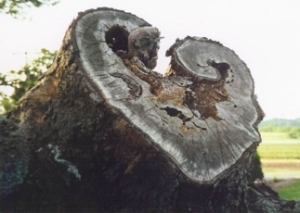
And I do believe all shall be well,
all manner of things shall be well,
when the fire and the rose are one.
text and photos ©Ani Williams
December 2003 issue of
Four Corners Magazine
The following CDs have songs dedicated to Magdalena:
https://aniwilliams.com/product/chalice-of-holy-fire-mp3/
https://aniwilliams.com/product/song-of-sophia-mp3/
https://aniwilliams.com/product/garden-of-the-magdalene-mp3/
“Magdalene’s Gift—Songs to the Beloved“
See the article:
Mary Magdalene: Mistress of the Grail
